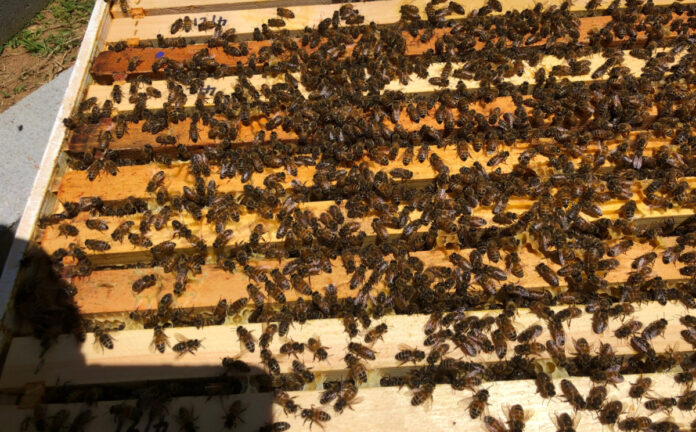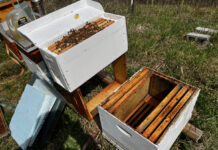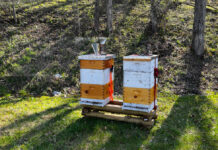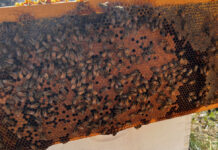Four or five days ago, I noticed the bees were zooming about like there was a big nectar flow going on. You can tell because they don’t waste any time lollygagging about on the entrance platform. The bees rush out of the hive entrance and immediately launch themselves, taking off in what I can only assume must be a “beeline.” There is a constant flow of bee activity as they come and go. This behavior is continuing, but they do not seem to be carrying pollen when they return, so I can only assume they are getting just nectar.
I am not sure what is the source of the nectar. Yes, there are wild flowers in our meadow (you might think of them as weeds) and in our early stage pollinator garden, but while I see bumble bees in there, I don’t see honey bees. I have guides to what is blooming when, but they do not take into account our altitude. My best guess is that it is the American Basswood tree (Tilia americana), also known as the Linden. I’m know they are in the woods all around us, but there are none in sight that I can look at and confirm they are blooming. There is also a possibility that it is clover. Or both.
Single vs Double Hive Management
Since this is my first year keeping bees in seven years, I am trying out some different approaches to see what works best for me. I have one hive in a single brood box with a super on top of it. In two weeks, they have almost filled the super and there are several completely capped frames. This hive is quite strong, full of bees with very little open space in the main hive body. There is a great deal of capped brood which should hatch within the next week. I added a new super to it to give the bees room to spread out and more room to put honey.
I have another hive with two full hive bodies on it, and this is also a very healthy hive to which I added a super last week. They have drawn out far less wax than the single hive body did in its first week. However, there are some very full and heavy frames of capped honey in the hive bodies.
I know many commercial beekeepers practice single hive management, and I can see why. That method produces more honey for the bee keeper than it does for the bees. I can see that after harvesting, I will need to heavily feed the single hive to prepare it for winter. The double hive already has a good amount of its own resources stored away.
As long as we have access to sugar, single hive body management will work for us. If we end up in a post-SHTF situation or a collapse where sugar is difficult to obtain then I believe having two full hive bodies will allow the bees to survive better without as much feeding.
BeeScanning App and Varroa
While inspecting the hives, I used the BeeScanning app to take pictures of the bees on the brood frames. Then I uploaded the images to their system where they counted the bees, analyzed the frames and the bees to find varroa mites and generic problems they call a “brood disorder.”
I scanned two hives before my phone told me it was overheated. Wow, I’ve never had that happen before, but I guess sitting on a beehive in full sun with the screen on for a long time caused it to overheat. I went inside, tossed the phone in the freezer for five minutes, and the problem cleared up. I waited a good half hour to let it cool further before I opened the third hive.
Results
In the phones below are some results of the BeeScanning analysis.
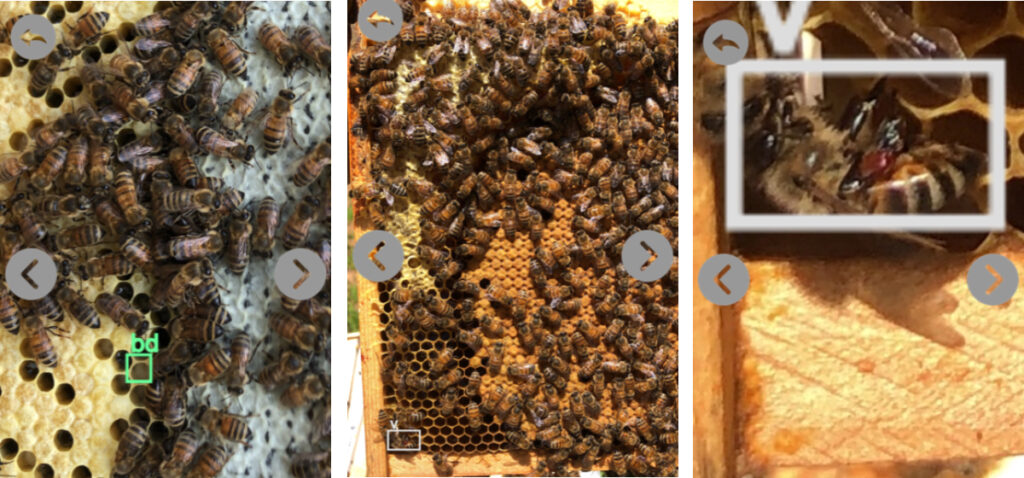
The app rated my three hives as no varroa, 0.22 percent varroa, and 0.74 percent varroa. However, close inspection reveals that there are two false positives. In one case, I believe the knee of a nearby bee was mistaken for a mite. In another, I just don’t see a mite at all. On the others, the mites are very obvious. So the app spotted four mites and had what I believe to be two false positives.
App Review
I am impressed with the Bee Scanning apps use of technology, but I think it needs some more time for the AI to be trained. (In all fairness, they warn you about this.) It reportedly spots about 80 percent of the varroa, but they don’t tell you how many they spot will be false positives.
As they continue to train the AI behind the app to improve accuracy and spot different hive problems, this will become an increasingly valuable tool, although it will be no use in a post-TEOTWAWKI scenario with no access to an Internet connection.
If the app had shown 3 or 4 percent of the bees with varroa, I would treat the hives immediately, knowing that it probably under counts. Right now, with my low counts, I am not satisfied enough with the results and will need to do an alcohol or similar test on my hives to determine the mite load and settle on a treatment plan. That’s a task for next weekend.

